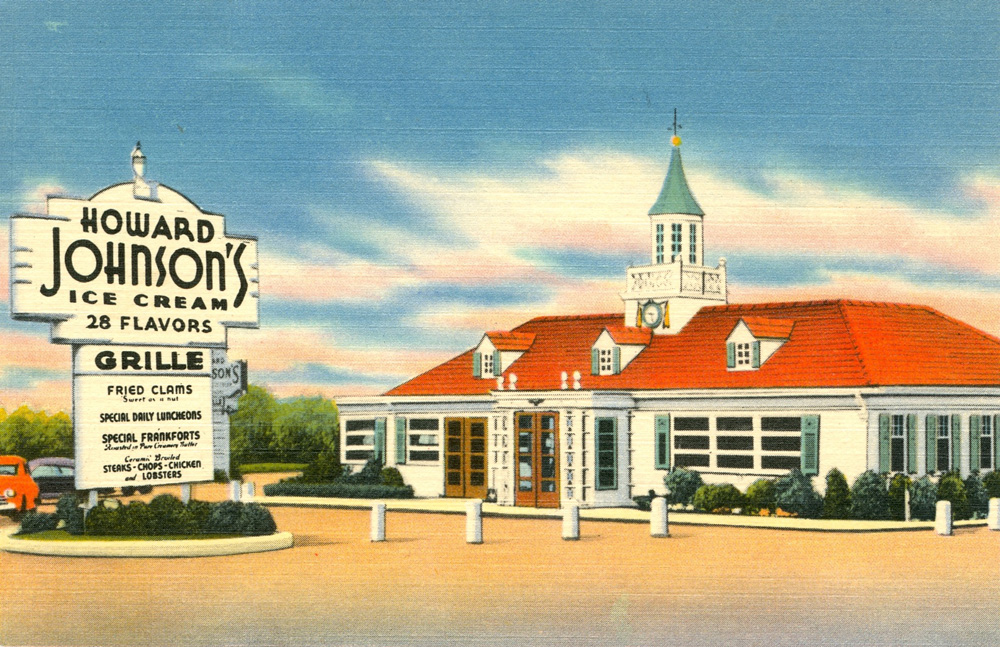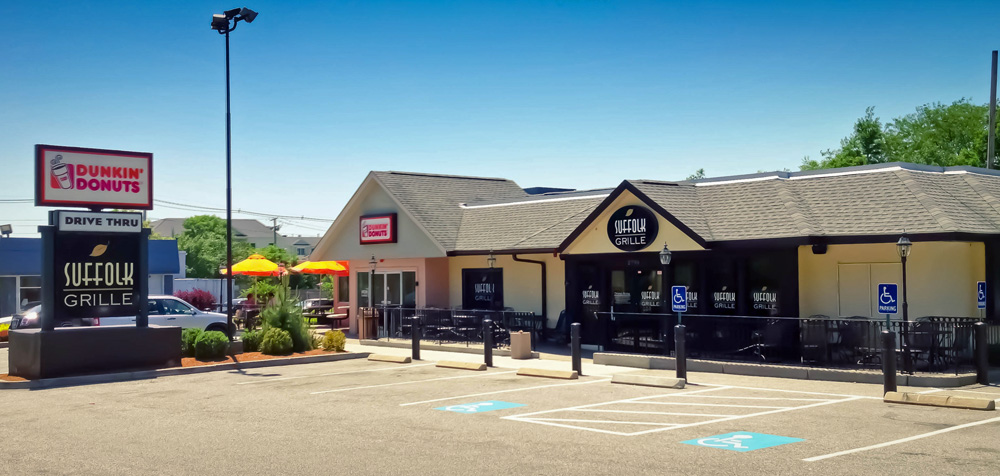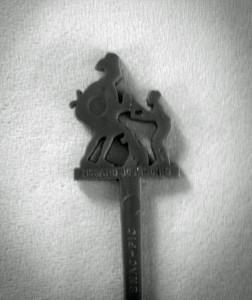True Tales from Canton’s Past: Remembering HoJo’s
By George T. Comeau
A postcard of the Howard Johnson’s at Route 138, which was the prototype for the food chain. (Courtesy of Rich Kummerlowe)
This story originally appeared in the Canton Citizen on June 6, 2013.
In a town where modern history extends back over 300 years, there are plenty examples of colonial architecture. But perhaps the most famous colonial revival building in Canton is largely hidden and destroyed by progress. To see this building as it exists today, travel down Turnpike Street almost to the foot of the Great Blue Hill. On the left, just as you are about to pass from Canton into Milton is a Dunkin Donuts. Beneath this modern façade is one of America’s most famous colonial style landmarks: Howard Johnson’s.
It all started in a drugstore in Wollaston and would grow to the largest hospitality chain in the world. How it grew, and the influence of the Canton location, is a rags to riches story that can only happen against the backdrop of struggle and perseverance.
Having served in the Yankee Division in World War I, Howard D. Johnson returned home to Quincy at age 27 to resume his pre-war business of selling cigars. After finding himself in debt, Johnson borrowed $2,000 in 1925 to purchase a drugstore in the seaside neighborhood of Wollaston. It turned out that the busiest section of the store was the soda fountain. And the center of attention at Johnson’s soda fountain was ice cream. People flocked to “Johnson’s” to enjoy a new recipe of ice cream, which, due to the high butterfat content, became the centerpiece of his establishment.
The automobile age was in full swing, and throughout the summers of the late 1920s Johnson opened up dozens of concession stands along the beaches of Massachusetts. In the early days the menus were simple: hotdogs, hamburgers, soft drinks, and Johnson’s “28 flavors” of ice cream. By the end of the 1920s, Johnson created his first sit-down establishment. The menu featured a few familiar items that many New Englanders will certainly identify with — fried clams, baked beans, chicken pot pies, hotdogs, and of course, ice cream.
After the stock market crash of 1929, Johnson began building an empire. The second restaurant to open was in Orleans on Cape Cod. Soon thereafter, through the first franchising agreements ever, spots opened in Dedham and Dorchester. By 1936 there were 41 established “Johnson’s” popping up all over Massachusetts. Canton was one of the earliest. What made Canton a great spot was not only the proximity to Quincy, but also the fact that it was a destination along a busy turnpike from Boston to Providence. Canton was not simply another restaurant in the chain — this location was different.
What made Canton special was the fact that it was the prototype for all of the other Howard Johnson’s in the country. It is said that the Canton location was “perhaps the best known image of a ‘colonial’ house to have originated in Boston during the twenties and thirties.” Designed by Joseph Morgan, it served as the prototype for the colonial revival design that would become a highway landmark. Built circa 1936, it was still standing intact at 2790 Washington Street in Canton until 1985.
It is hard to date the exact opening of the ice cream stand in Canton. There are a few hints, however. We know for sure it was there in the summer of 1936. The local paper ran a front-page story on August 28, 1936, with the headline “Second Break at Johnson’s Stand.” In less than two weeks, thieves had forced a window and “made off with a quantity of cigars.” It seems that cigars were easy pickings as more than 60 had been stolen 14 days before the second robbery. There was no report of a capture, and it is likely the evidence went up in smoke.
The year 1936 was a crime-riddled one for that small ice cream stand. On December 31, a police manhunt ensued through the Blue Hill Reservation. Canton Police Officer Thomas Galligan pursued a car from Johnson’s, which was found overturned a “short distance down the road to Boston.” Galligan had been investigating “a light in the rear of the building, saw the car dash away and followed it.” Losing sight of the car, he came upon it soon thereafter, “overturned, the registration plates had been stripped from it and the safe from the ice cream stand remained within, intact.” Inside the un-cracked safe was $250.
The early days of that Canton “Ho-Jo’s” were an amazing time for the infant chain. Design elements were developed in Canton and then exported out as new franchisees signed on. Things like the colonial style of the roof, the “Disney-esque” faux dormers, the cupola, and even the signage all started at the Canton prototype.
By the mid 1940s the testing of design and food took on a new role in the Canton location. Internal company documents list designs as the “Canton-type.” The design details of the dairy bar, the seating, and updated dining facilities would be modeled after the Canton location. Innovations in hospitality that started here continue to this day. Take, for example, the idea that a family of six or more could sit in booths next to each other and the wall partition between them could be removed to expand and accommodate the entire family. Well, that was developed and tested as part of the Canton location.
The exterior was extremely modernistic in tone. The roof had three tiny dormer windows trimmed with green blinds against a “rust colored Italian tile roof.” If it followed many of the other designs, Canton would have had a floor inset with a circle featuring “a boy and a dog looking longingly at the feast.” The same design carried out in the electric sign outside the restaurant and also in the weathervane atop the white spire over the building. The interior featured a vaulted ceiling, bronze chandeliers, and deep wood tones. It is likely that the tables were blue and the seats were of ivory and blue leather. Details within the design for franchise plans even indicated the colors of the draperies and venetian blinds.
What made Howard Johnson’s great was the fact that the menu and food were predictable, sensible and priced accordingly. This was achieved through producing the food in local commissaries, which served as distribution hubs, and delivering the food frozen to be re-prepared on-site. Pierre Franey and Jaques Pepin were first employed as executive chefs in 1959. Pepin, writing in the New York Times, said, “I flipped burgers, cooked hot dogs and learned about the specialties of the house, among them tender fried clams made from the tongues of enormous sea clams whose bodies were used as the base for the restaurants’ famous clam chowder. Other specialties I became familiar with included macaroni and cheese, hash browns, ice cream sundaes, banana splits, and, certainly, apple pies.” This is the food that made an empire.
Several Cantonites still swoon about that little Ho-Jo’s. And recently on the “You Know You Grew Up in Canton When…” Facebook page, the photo of the Turnpike Street landmark elicited some wonderful memories. Brad Bashner wrote of the chocolate ice cream, “To this day I can’t describe it, but there was something about it.” Jane Leahy recalled, “This was my first job! My father would drop me off and pick me up; I was too young to drive! Worked the counter and learned to tie a mean turquoise tie on my apron … we had to!” Mark Ronayne’s comment brings back the memories of the roadside attraction: “Onion rings and we owned the parking lot every Friday and Saturday night.”
By 1985, the Howard Johnson’s Company ended and a licensed owner took over and decided to once again turn the building into a prototype. By the early 1990s, after the Howard Johnson Company itself had been split apart, the Canton restaurant came to be operated by Franchise Associates Incorporated. The restaurant chain was in decline and Franchise Associates used the Canton location to make one notable attempt to create a Howard Johnson’s of the future — again a new prototype restaurant in Canton. Among the new design features was a modern arch over the entrance with a logo prominently displayed. Also, half of the legendary orange roof was changed to gray and the cupola was removed. It closed in 2000.
Unfortunately, the orange roof featuring the Simple Simon logo has disappeared. Jaques Pepin summed it up best: “For me, Howard Johnson’s reliable, modestly priced food embodies the straightforwardness of the American spirit.” And in Canton, we played our part in this uniquely American icon that casts a long shadow back to our colonial heritage and a time when food was simply as good as ice cream on a hot summer day at the foot of Blue Hill.
Click here to see a film clip of Canton’s Howard Johnson’s in 1941.
Short URL: https://www.thecantoncitizen.com/?p=20886












